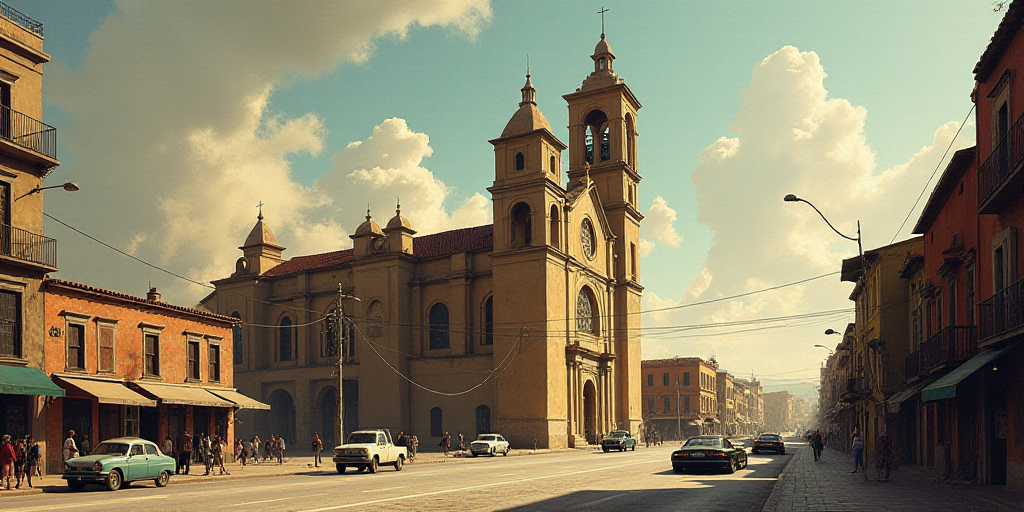I. The Sinking Cathedral: A Monumental Architectural Superego: Morality, Punishment, and Mexico’s Descension
Located in the Historic Center of Mexico City, the Cathedral transcends being just a building; it’s a watchful body, an architectural embodiment of what should be. This narrative revolves around symbolic control, colonial desire, embodied resistance, and Viceregal construction.
The term “cathedral” originates from ‘cathedra,’ meaning the bishop’s chair—the place where authority teaches. It’s not just any teaching; it’s the dissemination of doctrine.
This space legitimizes a single authoritative voice, demanding others to listen, kneel, and obey. Each colonial cathedral in the Americas wasn’t merely a spiritual center but also a repeater of imperial power.
At a rate of 40 centimeters per year, the Cathedral sinks unevenly and incessantly. Despite engineering interventions since the 1990s—including pilot installations, concrete injections, and continuous structural monitoring—the sinking persists.
II. Threshold: The Stone Crime at the Heart of Mexica Universe
The Cathedral wasn’t built directly over the Templo Mayor, but it was erected on its remnants: ritual platforms, minor temples, and the Calmécac. The symbolic gesture was clear: bury a solar axis beneath a Christian stone body.
III. The Monumental Superego: An Architectural Guide and Watcher
Similar to the superego in psychoanalysis, the Cathedral imposes, accompanies, and offers redemption. The superego doesn’t guide; it demands, corrects, and punishes. It offers norms instead of desires and delineates paths rather than opening them. Each chime rewrites solar time into Christian time.
The Cathedral was constructed to celebrate the spirit and enforce a colonial, religious, and moral system.
IV. A Colonized Mind: The Divided Style
The Cathedral embodies a lack of stylistic unity, blending baroque, gothic, and neoclassical styles. It’s the architectural expression of a mind imposed over centuries of civilization.
V. The Sinking as Symbolism
And the Cathedral literally sinks. The symbolic weight of its morality collapses onto a ground that cannot support it.
However, it transcends from other places; it dreams while the bodies that once floated—the saints, mystics, disobedient bodies—linger in memory. There’s no law of being that doesn’t collapse with time.
In Catholic annals, there are bodies that defy gravity. San José de Cupertino levitated before the altar, forgetting later how. Santa Teresa de Ávila described the terror of being dragged into the air without resistance. San Felipe Neri burst into flames from his chest and floated. Cristina la Admirable reportedly flew literally across the rooftops, according to witnesses.
These disobedient bodies were not heretics but saints. Their elevation wasn’t an act of rebellion; it was a crack in the architectural structure of what should be.
In those moments, the body didn’t kneel; it detached.
This sinking is the physical symptom of a symbolic structure that can no longer sustain itself.
There is no floating punishment. There is no law of being that doesn’t collapse with time.
What happens when a Saint floats in the air?
VI. The City as a System of Symbolic Orders, the Tamed Body
Franciscans, Dominicans, Jesuits, Augustinians, Mercedarians, Carmelites, and Juaninos. Each religious order not only established temples in Mexico City’s Historic Center but also nurtured brilliant minds of the Viceregal world for three centuries.
The Franciscans imposed the vow of poverty; the Jesuits, enlightened reason; the Dominicans, the punished word; the Augustinians, silence as dogma.
Within Mexico City’s Metropolitan Cathedral, since its construction beginning in 1524 when Hernán Cortés ordered a temporary wooden and adobe church over the Mexica ceremonial center, the main altar is the heart.
The central nave is the torso; the crucero (where nave and transept intersect) forms outstretched arms. The apse represents the head; crypts or catacombs symbolize the entrails, the hidden, the subterranean.
Towers signify thought’s ascension, vision. This design wasn’t accidental; it was believed that entering a cathedral meant entering the glorified body of Christ.
Your own body should conform to this ideal form: vertical, symmetrical, moral, penitent.
Just as the body bows before the cross, temple architecture demands corporal obedience.
It compels you to look up (hierarchy); to enter silence (submission); to be part of an ordered, repetitive line (uniformity); to stand before an inaccessible altar (distance between the sacred and the living).
VII. The Holy Office: Body Before the Fire, Soul Before Judgment
The Santo Oficio tribunal was established at the corner of Republica de Brasil and Belisario Dominguez.
Autos de fe, tortures, re-education, public humiliation.
It didn’t need to kill to control; it was enough that everyone knew it could. Approximately thousands were tortured, hundreds killed, and many others condemned to severe penalties like imprisonment, exile, confiscation of goods, sambenitos, and public autos de fe lasting hours, possibly including processions, masses, sermons, reading of sentences, and enactment of punishment.
Punishment was code; it shaped the body, desire, and voice.
VIII. The Displaced Axis: Architecture of the Residue
The Cathedral is next to the Templo Mayor. Why? So that the former axis of the Mexica universe’s center doesn’t disappear but becomes residue.
The ancient center, the Templo Mayor, as the universe’s center, axis mundi, remains destroyed beneath Spanish constructions, serving no purpose.
Colonial power doesn’t eliminate; it decentralizes. It doesn’t deny the Mexica sacred; it surrounds, encloses, and reprograms it.
Just as the superego doesn’t suppress desire but monitors it from the side.
IX. Tonantzin Overlaid: Disguised Devotion, Transfigured Punishment
Syncretism is survival with devotion. Amidst the remnants of the Templo Mayor and baroque altars, Tonantzin is transformed into Guadalupe, a dark-skinned Virgin painted over an older, more earthly one. Copal is replaced with incense, the teponaztli drowned by the organ, and a Christian cross overlays the Mexica’s four-directional cross.
Punishment is conversion. Sacrifice in both cultures is an offering of flesh and blood.
X. Glorious Body: Where Art is Incarnated Doctrine
Plans, catacombs, roofs, religious ecstasy, art—all contribute to the overwhelming beauty experienced every visit.
The city is a choreographed symbolic displacement.
XI. Baroque Surrealism: Vigilance Without Center
The Cathedral continues to sink.
The ground doesn’t support it, yet it doesn’t let it go. It’s a submerged, baroque, distorted surveillance.
Like Mexico itself: moral ambiguity, formless guilt, directionless surveillance.
Axes are displaced, centers distorted, directions rewritten.
XII. Final Delirium: The Inclined is Also Sacred
The Cathedral curves, cracks, and sinks.
It leans, it twists. It watches from imbalance.
Because the ground in Tenochtitlan was a lake.
Construction took approximately 240 years, a constant, relentless movement.
In this very movement, the Mexican surrealism was born—not as an aesthetic school but as a way to inhabit the impossible.
The Mexican lives on unstable ground and builds surveillance structures.
A city designed not on logical reasons but on a dream, on a foundational myth: the mítico águila y la serpiente.
It’s a clear reminder that we all will vanish.
Yet, we love.
We love the impossible, the inclined.
It sinks, just like us.
And that too, is sacred.






